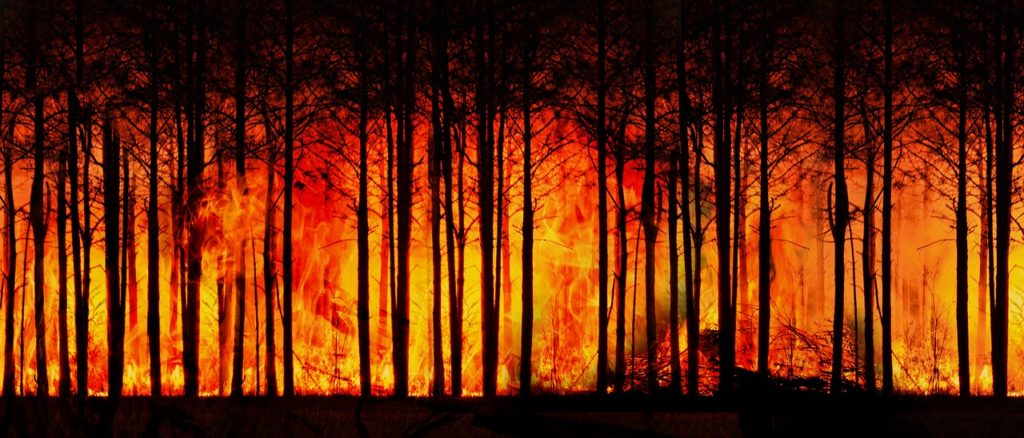
Originally published by The 19th
As the West’s wildfire season worsens, a new Human Rights Watch report urges policymakers to address the toll it’s taking on pregnancy and birth outcomes.
By Jessica Kutz
The 19th’s’s Gender, climate and sustainability reporter
In the midst of yet another hazy summer, as over 50 large fires burn in the West, a new report published today by Human Rights Watch examines the growing risk that fire season poses to pregnant people and lays out recommendations for how to address the threat.
The international advocacy organization worked with Nurturely, a nonprofit focused on perinatal care in Oregon, to interview over 50 birth workers like doulas and midwives, public health officials and climate experts to better understand how wildfire seasons in the state are playing out for pregnant people. The authors learned that wildfire smoke is becoming a mental health stressor for pregnant people, and that for low-income residents, information about smoke hazards — and solutions for how to protect themselves — can be out of reach.
“Before we did the research, we knew that many of the chemicals inside wildfire smoke are well known to be reproductive toxins. We also knew that there was a growing body of epidemiology that was showing that there was a link between wildfire exposure and adverse birth outcomes,” said Skye Wheeler, a senior researcher and the report’s lead author. “But what we couldn’t see was what it actually felt like on the ground. And to better understand that, we turned to the people working on the real front lines of where the climate crisis meets human health and wellbeing.”
It’s a viewpoint that Kate Kelly, senior director of the Women’s Initiative at the Center for American Progress, a think tank, said is sometimes missing from public health policy. “It’s not always how we arrive at our policy recommendations — just asking normal people what they need,” she said. “So I thought that was unique and impactful.”
A combination of climate change and decades of poor forest management means longer and more intense wildfire seasons. More “mega fires,” or fires that burn more than 100,000 acres, are expected in the coming years. Their smoky plumes release particle pollution from organic matter like trees, but also toxic pollution from burning homes, like plastic and household chemicals.
There is a growing body of research about the effects of wildfire smoke on pregnancy, but it’s in early stages, said Emilia Basilio, an assistant professor in maternal and fetal medicine at the University of California, San Francisco. “What we do know is that there’s a definite link with wildfire smoke and preterm birth, so babies being born ahead of time, which can lead to complications like low birth weight.”
Your trusted source for contextualizing environment and climate news. Sign up for our daily newsletter.
Air pollution research also makes scientists think that wildfire smoke could be linked to pregnancy complications like preeclampsia, a potentially life-threatening condition that causes high blood pressure, she said. “That link has been substantiated with a lot of air pollution data, and we know that wildfire smoke has the same sort of composition as air pollution in terms of particulate matter — especially particulate matter that’s very small, so less than 2.5 microns in size, which is what we inhale,” she said. “It gets into our bloodstream and also kind of deposits into the placenta.”
For many of the doulas and midwives Wheeler interviewed, the threats extend beyond physical concerns. In addition to pre-existing health conditions like asthma, “the people that our interviewees were often most concerned about were people with pre-existing mental health conditions like depression or anxiety,” Wheeler said. “When you wake up every day for like, one, two or three weeks and the air is full of smoke and the light is strange and the sky is dark, this is all having a real impact on the health of pregnant people, and a real impact on anxiety as well.”
In the report, doula Katie Minich said she feels like wildfire season makes it harder to have a normal pregnancy now. “There’s a lot more anxiety,” she told the researchers. “Pregnant people must worry: What if I go into labor when I’m trying to evacuate? A lot of things are more uncertain, things we used to take for granted.”
Research on this topic is extremely limited, said Wheeler, so one of her recommendations in the report is to fund more of it. “We have every reason to suspect that the climate crisis is impacting maternal mental health,” she said.
The report also examines the barriers that keep pregnant people from protecting themselves from wildfire smoke. Low-income communities of color are more susceptible to exposure due to poor housing stock, homelessness, people working in outdoor jobs like farmworking and having less information about environmental threats to pregnancy.
“While we have very top-down, very broad advice from public health officials — including, for example, the CDC and EPA providing some insights for pregnant people about what they should do on wildfire smoke days,” Wheeler said, “it’s not that easy to put that advice into action.”
For example, measures like buying air purifiers or air conditioners can be too costly. Living in poor housing stock often means that smoke can seep through leaky windows and doors. And when a wildfire hits and the air quality worsens, these communities are less likely to evacuate either due to the expense or not having nearby family who can take them in.
Birth workers play an important role in filling in some of the information gaps and can connect patients to resources, said Wheeler. “We found that quite often, community-oriented birth workers like midwives or doulas were providing information to patients, and that’s because people were asking them. They were using the best advice that they could get and trying to make it as useful as possible for pregnant people, and to try and provide a sense of comfort where they could.”
Kelly, whose organization released a report on the role birth workers play in public health, said those workers are also key to lowering the risks of poor maternal health outcomes. Black women in the United States are three times more likely to die in childbirth than White women. “Regardless of natural disasters or a public health crisis like a pandemic, the country overall faces a dire maternal health crisis, and this crisis disproportionately impacts women of color,” she said. “Doulas can help bridge the gap in the quality of care people receive, and sort of disrupt the cycle of harm caused by a biased healthcare system that doesn’t serve them.”
The report offered several recommendations, including providing better education for pregnant people on environmental health risks, more outreach to those from marginalized communities when wildlife smoke or poor air quality is a concern, increasing access to air purifiers and housing weatherization programs, and expanding support for birth workers. The report also recommends greater coordination at the federal level, including adding reproductive justice experts to the Environmental Protection Agency’s environmental justice office.
But, Wheeler said, none of these recommendations are going to be enough if the root cause of the problem isn’t addressed. “What we heard very clearly from more than half of the people we interviewed was that we need big climate action,” she said. “We need massive reduction in fossil fuel burning, that this [crisis] is fundamentally changing how amenable to new life and pregnancy health our environment is.”


